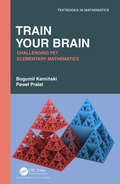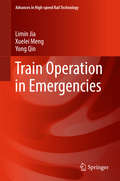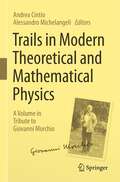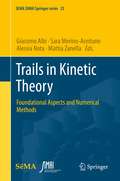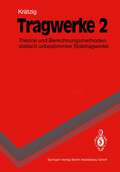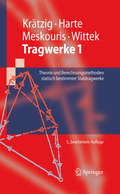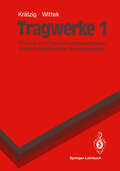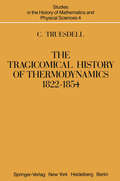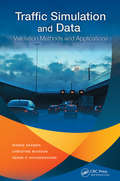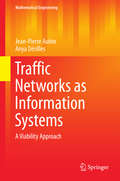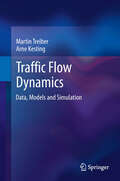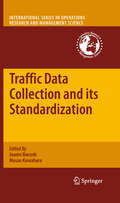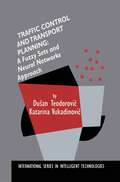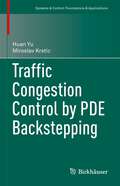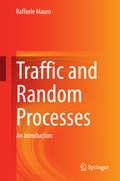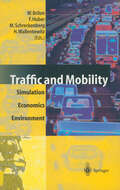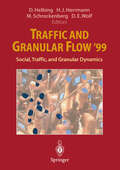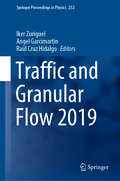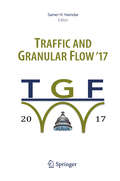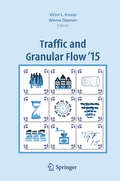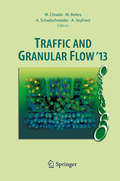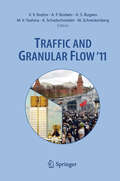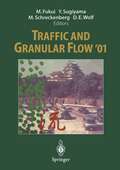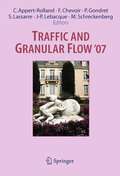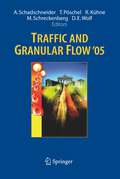- Table View
- List View
Train Your Brain: Challenging Yet Elementary Mathematics (Textbooks in Mathematics)
by Bogumil Kaminski Pawel PralatThis accessible book helps readers to see the bigger picture of advanced mathematics. The book contains carefully selected, challenging problems in an easy-to-follow, step-by-step process. Neither prior preparation nor any mathematical sophistication is required. The authors guide the reader to “train their brain” to think and express themselves in a rigorous, mathematical way, and to extract facts, analyze the problem, and identify main challenges. A firm foundation in a diverse range of topics is presented. Moreover, the authors show how to draw appropriate, true conclusions. Computer support is used to better intuition into discussed problems. The book is designed for self-study. It can be used to bridge the gap between introductory calculus/linear algebra courses and more advanced courses offered at universities. It improves the ability to read, write, and think in a rigorous, mature mathematical fashion. The reader will develop a deeper understanding in preparation to succeed in more advanced course work. Features•The authors employ a six-step process: 1.SOURCE2.PROBLEM3.THEORY4.SOLUTION5.REMARK6.EXERCISES •An Appendix introduces programming in Julia This book is also suitable for high school students that are interested in competing in math competitions or simply for people of all ages and backgrounds who want to expand their knowledge and to challenge themselves with interesting questions.
Train Operation in Emergencies (Advances in High-speed Rail Technology)
by Limin Jia Xuelei Meng Yong QinThis book presents the latest findings on train operation theories and methods in the context of emergencies. It examines and assesses a range of aspects—including the definition of a railway emergency, transport organization modes in emergencies, calculating railway transport capacity in emergencies, line planning in emergencies, train re-pathing in emergencies and train re-scheduling in emergencies—that are urgently needed in the railway transportation field, which faces the serious challenge of dealing with emergencies worldwide. The book highlights the latest research results in an integrated and systematic way, and the methodology presented is oriented on real-world problems, allowing it to be used not only directly in railway operational management, but also as the point of departure for further applications or theoretical research. As such, the book will be of considerable interest to graduate students and researchers in the field of traffic and transportation engineering.>
Trails in Modern Theoretical and Mathematical Physics: A Volume in Tribute to Giovanni Morchio
by Andrea Cintio Alessandro MichelangeliThis book celebrates the life and work of the late Giovanni Morchio (1944–2021). It features scientific and anecdotal contributions written by his former colleagues, co-authors, and students, as well as senior scientists who were active witnesses to the dramatic advances in physics and in mathematics that took place during his 50-year-long career. The volume begins with a biographical introduction, detailing Giovanni Morchio’s life and his role as a physicist, mathematician, teacher, and scientist. The core of the book covers a vast spectrum of ideas, reflecting Dr Morchio’s scientific interests. Each chapter develops a specific topic of modern research, ranging from quantum mechanics and quantum field theory to additional themes such as the connection between general relativity and Newtonian gravitation. Every contribution provides a historical retrospective, a survey of advances, an outlook of future perspectives and challenges, and an updated bibliography. The last part collects the authors’ recollections of their professional and personal interactions with Dr Morchio, in recognition of his deep achievements, his exceptional pedagogical qualities, and his praiseworthy social and pro bono commitment. Authored by physicists of international calibre covering a broad range of subjects, the book will be a valuable reference for researchers and students of theoretical and mathematical physics.
Trails in Kinetic Theory: Foundational Aspects and Numerical Methods (SEMA SIMAI Springer Series #25)
by Giacomo Albi Sara Merino-Aceituno Alessia Nota Mattia ZanellaIn recent decades, kinetic theory - originally developed as a field of mathematical physics - has emerged as one of the most prominent fields of modern mathematics. In recent years, there has been an explosion of applications of kinetic theory to other areas of research, such as biology and social sciences. This book collects lecture notes and recent advances in the field of kinetic theory of lecturers and speakers of the School “Trails in Kinetic Theory: Foundational Aspects and Numerical Methods”, hosted at Hausdorff Institute for Mathematics (HIM) of Bonn, Germany, 2019, during the Junior Trimester Program “Kinetic Theory”. Focusing on fundamental questions in both theoretical and numerical aspects, it also presents a broad view of related problems in socioeconomic sciences, pedestrian dynamics and traffic flow management.
Tragwerke 2: Theorie und Berechnungsmethoden statisch unbestimmter Stabtragwerke (Springer-Lehrbuch)
by Wilfried B. KrätzigTragwerke 1: Theorie und Berechnungsmethoden statisch bestimmter Stabtragwerke (Springer-Lehrbuch)
by Wilfried B. Krätzig Reinhard Harte Konstantin Meskouris Udo WittekDas Standardlehrwerk beschäftigt sich mit der Ermittlung der Kraft- und Verformungszustände von allgemeinen, statisch bestimmten Stabtragwerken sowie von wichtigen Tragwerkstypen. Dabei vereint es die Grundlagen der technischen Mechanik mit der konzeptionellen, tragwerksspezifischen Problemlösung. Dargestellt werden die fundamentalen Abstraktions- und Arbeitsmethoden, die wesentlichen analytischen Berechnungsmethoden werden an typischen Beispielen erläutert. Die Neuauflage berücksichtigt aktuelle Normen und neue Bezeichnungen.
Tragwerke 1: Theorie und Berechnungsmethoden statisch bestimmter Stabtragwerke (Springer-Lehrbuch)
by Wilfried B. Krätzig Udo WittekGott bietet uns alle Güter dieser Welt um den Preis der Arbeit. Leonardo da Vinci, 1452-1519 Das vorliegende Lehrbuch zur Statik statisch bestimmter Stabtragwerke ist als vorlesungsbegleitende Lektüre der Lehrveranstaltungen gleichen Namens an der Ruhr-Universität Bochum und der Universität Kaiserslautern konzipiert worden. Seine Erstausgabe entstand 1971; das vorliegende Manuskript stellt eine dritte, nunmehr grundlegende Neubearbeitung dar. Ein wichtiger Aufgabenbereich aller konstruktiv gestaltenden Bauingenieure besteht darin, die Kraft- und Weggrößenzustände von Tragwerken als Grundlage ihrer sicheren Dimensionierung hinreichend genau zu bestimmen. In der Statik der Tragwerke werden daher Hypothesen und Erkenntnisse der Technischen Mecha nik, dargestellt in der Sprache der Mathematik, auf dieses Ziel hin orientiert. Ausgehend von diesen Grundkonzepten führt deshalb das Buch in fundamentale Denk- und Arbeitsmethoden von Festigkeitsberechnungen ein und entwickelt gleichzeitig die wichtigsten Analyseverfahren für statisch bestimmte Stabtragwer ke. Deren Anwendungen werden in einer Vielzahl von Beispielen erläutert, wobei wichtige Rechenschritte und getroffene Idealisierungen besonders hervorgehoben werden. Hauptzweck der sorgfältig dokumentierten Beispiele für den Leser sollte jedoch das Eindenken in das Tragverhalten einfacher Strukturen sein.
The Tragicomical History of Thermodynamics, 1822–1854 (Studies in the History of Mathematics and Physical Sciences #4)
by C. TruesdellTraffic Simulation and Data: Validation Methods and Applications
by Winnie Daamen Christine Buisson Serge P. HoogendoornA single source of information for researchers and professionals, Traffic Simulation and Data: Validation Methods and Applications offers a complete overview of traffic data collection, state estimation, calibration and validation for traffic modelling and simulation. It derives from the Multitude Project-a European Cost Action project that incorpo
Traffic Networks as Information Systems: A Viability Approach (Mathematical Engineering)
by Jean-Pierre Aubin Anya DésillesThis authored monograph covers a viability to approach to traffic management by advising to vehicles circulated on the network the velocity they should follow for satisfying global traffic conditions;. It presents an investigation of three structural innovations: The objective is to broadcast at each instant and at each position the advised celerity to vehicles, which could be read by auxiliary speedometers or used by cruise control devices. Namely, 1. Construct regulation feedback providing at each time and position advised velocities (celerities) for minimizing congestion or other requirements.2. Taking into account traffic constraints of different type, the first one being to remain on the roads, to stop at junctions, etc. 3. Use information provided by the probe vehicles equipped with GPS to the traffic regulator;4. Use other global traffic measures of vehicles provided by different types of sensors; These results are based on convex analysis, intertemporal optimization and viability theory as mathematical tools as well as viability algorithms on the computing side, instead of conventional techniques such as partial differential equations and their resolution by finite difference or finite elements algorithms. The target audience primarily covers researchers and mathematically oriented engineers but the book may also be beneficial for graduate students.
Traffic Flow Dynamics: Data, Models and Simulation
by Martin Treiber Arne KestingThis textbook provides a comprehensive and instructive coverage of vehicular traffic flow dynamics and modeling. It makes this fascinating interdisciplinary topic, which to date was only documented in parts by specialized monographs, accessible to a broad readership. Numerous figures and problems with solutions help the reader to quickly understand and practice the presented concepts. This book is targeted at students of physics and traffic engineering and, more generally, also at students and professionals in computer science, mathematics, and interdisciplinary topics. It also offers material for project work in programming and simulation at college and university level.The main part, after presenting different categories of traffic data, is devoted to a mathematical description of the dynamics of traffic flow, covering macroscopic models which describe traffic in terms of density, as well as microscopic many-particle models in which each particle corresponds to a vehicle and its driver. Focus chapters on traffic instabilities and model calibration/validation present these topics in a novel and systematic way. Finally, the theoretical framework is shown at work in selected applications such as traffic-state and travel-time estimation, intelligent transportation systems, traffic operations management, and a detailed physics-based model for fuel consumption and emissions.
Traffic Data Collection and its Standardization (International Series in Operations Research & Management Science #144)
by Jaume Barceló Masao KuwaharaA nice night of October 2007, in Beijing, during the XV World Conference on ITS a number of colleagues met informally for a dinner party that spontaneously became a vivid discussion on the importance of traffic data for all types of p- poses. Researchers can hardly do any progress in modeling, developing, and te- ing theories without suitable data, and what practitioners can do in real life is limited not only by technology but also by the availability of the required data. Quite frequently, the data and not the technologies are what determine how far we can go. Any discussion about traffic data leads in a natural way to a discussion on the variety of traffic data sources, formats, levels of aggregation, accuracies, and so on. Consequently, we moved to talk on the initiative that Kuwahara had undertaken in his traffic laboratory at the University of Tokyo, known as the International Traffic Data Base, and thus smoothly but inexorably we came to agree that it would be convenient to organize a workshop to continue our discussion at a more formal level, share our points of view with other colleagues, listen what they had to say and, if possible, d- seminate the findings in our professional and academic communities.
Traffic Control and Transport Planning: A Fuzzy Sets and Neural Networks Approach (International Series in Intelligent Technologies #13)
by Dusan Teodorovic Katarina VukadinovicWhen solving real-life engineering problems, linguistic information is often encountered that is frequently hard to quantify using "classical" mathematical techniques. This linguistic information represents subjective knowledge. Through the assumptions made by the analyst when forming the mathematical model, the linguistic information is often ignored. On the other hand, a wide range of traffic and transportation engineering parameters are characterized by uncertainty, subjectivity, imprecision, and ambiguity. Human operators, dispatchers, drivers, and passengers use this subjective knowledge or linguistic information on a daily basis when making decisions. Decisions about route choice, mode of transportation, most suitable departure time, or dispatching trucks are made by drivers, passengers, or dispatchers. In each case the decision maker is a human. The environment in which a human expert (human controller) makes decisions is most often complex, making it difficult to formulate a suitable mathematical model. Thus, the development of fuzzy logic systems seems justified in such situations. In certain situations we accept linguistic information much more easily than numerical information. In the same vein, we are perfectly capable of accepting approximate numerical values and making decisions based on them. In a great number of cases we use approximate numerical values exclusively. It should be emphasized that the subjective estimates of different traffic parameters differs from dispatcher to dispatcher, driver to driver, and passenger to passenger.
Traffic Congestion Control by PDE Backstepping (Systems & Control: Foundations & Applications)
by Huan Yu Miroslav KrsticThis monograph explores the design of controllers that suppress oscillations and instabilities in congested traffic flow using PDE backstepping methods. The first part of the text is concerned with basic backstepping control of freeway traffic using the Aw-Rascle-Zhang (ARZ) second-order PDE model. It begins by illustrating a basic control problem – suppressing traffic with stop-and-go oscillations downstream of ramp metering – before turning to the more challenging case for traffic upstream of ramp metering. The authors demonstrate how to design state observers for the purpose of stabilization using output-feedback control. Experimental traffic data are then used to calibrate the ARZ model and validate the boundary observer design. Because large uncertainties may arise in traffic models, adaptive control and reinforcement learning methods are also explored in detail. Part II then extends the conventional ARZ model utilized until this point in order to address more complex traffic conditions: multi-lane traffic, multi-class traffic, networks of freeway segments, and driver use of routing apps. The final chapters demonstrate the use of the Lighthill-Whitham-Richards (LWR) first-order PDE model to regulate congestion in traffic flows and to optimize flow through a bottleneck. In order to make the text self-contained, an introduction to the PDE backstepping method for systems of coupled first-order hyperbolic PDEs is included. Traffic Congestion Control by PDE Backstepping is ideal for control theorists working on control of systems modeled by PDEs and for traffic engineers and applied scientists working on unsteady traffic flows. It will also be a valuable resource for researchers interested in boundary control of coupled systems of first-order hyperbolic PDEs.
Traffic and Random Processes: An Introduction
by Raffaele MauroThis book deals in a basic and systematic manner with the fundamentals of random function theory and looks at some aspects related to arrival, vehicle headway and operational speed processes at the same time. The work serves as a useful practical and educational tool and aims at providing stimulus and motivation to investigate issues of such a strong applicative interest. It has a clearly discursive and concise structure, in which numerical examples are given to clarify the applications of the suggested theoretical model. Some statistical characterizations are fully developed in order to illustrate the peculiarities of specific modeling approaches; finally, there is a useful bibliography for in-depth thematic analysis.
Traffic and Mobility: Simulation — Economics — Environment
by Werner Brilon Felix Huber Michael Schreckenberg Henning WallentowitzAnyone who reflects on the future of society cannot do so without at the same time thinking about the future of our transportation systems. The dilemma is obvious. On the one hand, mobility must be maintained as it is crucial to economic development and because people are eager for individual mobility. On the other hand, traffic imposes heavy burdens on people and on the environment, on cities and communities and on our national economies. Finding a solution to that dilemma seems to be difficult, in fact we have not even developed a rough idea of how it could look like. This is why the North Rhine-Westphalia Science and Research Ministry came up with the plan to work out a well-founded scientific basis on which to solve the problems inherent in our transport system. A research network has been established and sponsored with government funds for a period of three years with a view to realising that objective. The "Traffic Simulation and Environmental Impact" research network is composed of researchers who have an excellent reputation as North Rhine-Westphalia traffic experts. Cutting across various disciplines of knowledge, the network aims to integrate transportation and natural sciences, particularly physics and mathematics, in a move to profit by the synergy between technical know-how and innovative methodology. The present volume is intended as a progress report and a prologue to the forthcoming international colloquium which represents the highlight and at the same time the end of the three-year project funding period.
Traffic and Granular Flow ’99: Social, Traffic, and Granular Dynamics
by D. Helbing H. J. Herrmann M. Schreckenberg D. E. Wolf"Are there common phenomena and laws in the dynamic behavior of granular materials, traffic, and socio-economic systems?" The answers given at the international workshop "Traffic and Granular Flow '99" are presented in this volume. From a physical standpoint, all these systems can be treated as (self)-driven many-particle systems with strong fluctuations, showing multistability, phase transitions, non-linear waves, etc. The great interest in these systems is due to several unexpected new discoveries and their practical relevance for solving some fundamental problems of today's societies. This includes intelligent measures for traffic flow optimization and methods from "econophysics" for stabilizing (stock) markets.
Traffic and Granular Flow 2019 (Springer Proceedings in Physics #252)
by Iker Zuriguel Angel Garcimartín Raúl Cruz HidalgoThis book gathers contributions on a variety of flowing collective systems. While primarily focusing on pedestrian dynamics, they also reflect the latest developments in areas such as vehicular traffic and granular flows and address related emerging topics such as self-propelled particles, data transport, swarm behavior, intercellular transport, and collective dynamics of biological systems. Combining fundamental research and practical applications in the various fields discussed, the book offers a valuable asset for researchers and practitioners alike.
Traffic and Granular Flow '17
by Samer H. HamdarThis book presents 57 peer-reviewed papers from the 12th Conference on Traffic and Granular Flow (TGF) held in Washington, DC, in July 2017. It offers a unique synthesis of the latest scientific findings made by researchers from different countries, institutions and disciplines.The research fields covered range from physics, computer science and engineering and they may be all grouped under the topic of "Traffic and Granular Flow". The main theme of the Conference was: "From Molecular Interactions to Internet of Things and Smart Cities: The Role of Technology in the Understanding and the Evolution of Particle Dynamics".
Traffic and Granular Flow '15
by Victor L. Knoop Winnie DaamenThe Conference on Traffic and Granular Flow brings together international researchers from different fields ranging from physics to computer science and engineering to discuss the latest developments in traffic-related systems. Originally conceived to facilitate new ideas by considering the similarities of traffic and granular flow, TGF'15, organised by Delft University of Technology, now covers a broad range of topics related to driven particle and transport systems. Besides the classical topics of granular flow and highway traffic, its scope includes data transport (Internet traffic), pedestrian and evacuation dynamics, intercellular transport, swarm behaviour and the collective dynamics of other biological systems. Recent advances in modelling, computer simulation and phenomenology are presented, and prospects for applications, for example to traffic control, are discussed. The conference explores the interrelations between the above-mentioned fields and offers the opportunity to stimulate interdisciplinary research, exchange ideas, and meet many experts in these areas of research.
Traffic and Granular Flow '13
by Mohcine Chraibi Maik Boltes Andreas Schadschneider Armin SeyfriedThis book continues the biannual series of conference proceedings, which has become a classical reference resource in traffic and granular research alike, and addresses the latest developments at the intersection of physics, engineering and computational science. These involve complex systems, in which multiple simple agents, be they vehicles or particles, give rise to surprising and fascinating phenomena.The contributions collected in these proceedings cover several research fields, all of which deal with transport. Topics include highway, pedestrian and internet traffic; granular matter; biological transport; transport networks; data acquisition; data analysis and technological applications. Different perspectives, i.e., modeling, simulations, experiments, and phenomenological observations are considered.
Traffic and Granular Flow '11
by Valery V. Kozlov, Alexander P. Buslaev, Alexander S. Bugaev, Marina V. Yashina, Andreas Schadschneider and Michael SchreckenbergThis book continues the biannual series of conference proceedings, which has become a classical reference resource in traffic and granular research alike. It addresses new developments at the interface between physics, engineering and computational science. Complex systems, where many simple agents, be they vehicles or particles, give rise to surprising and fascinating phenomena. The contributions collected in these proceedings cover several research fields, all of which deal with transport. Topics include highway, pedestrian and internet traffic, granular matter, biological transport, transport networks, data acquisition, data analysis and technological applications. Different perspectives, i.e. modeling, simulations, experiments and phenomenological observations, are considered.
Traffic and Granular Flow ’01
by Minoru Fukui Yuki Sugiyama Michael Schreckenberg Dietrich E. WolfDuring the last decade physicists, engineers and computer scientists have joined in an enormously fruitful dialogue about traffic and granular flow. Cars and sand grains have in common, that they interact irreversibly, which is the reason for similar jamming phenomena. The main difference is that car drivers choose their destination and route individually, while grains follow external driving forces. This book gives an overview about the progress in modelling, computer simulation, experiments and field observations, which was reached within the last two years. The contributions are based on the International Workshop Traffic and Granular Flow '01, which took place in Nagoya, 15 - 17 October 2001. Topics include a critical classification of models for highway traffic, new technological applications, friction and arching phenomena in pedestrian traffic, scale free networks and internet traffic, instabilities and fluctuations in avalanches and granular pipe flow.
Traffic and Granular Flow ' 07
by François Chevoir Philippe Gondret Sylvain Lassarre Jean-Patrick Lebacque Michael Schreckenberg Cécile Appert-RollandTraffic and Granular Flow ' 05
by Andreas Schadschneider Thorsten Pöschel Reinhart Kühne Michael Schreckenberg Dietrich E. WolfThis book again continues the biannual series of (now six) conference proceedings, which has become a classical reference in traffic and granular research alike. It addresses new developments at the borderline between physics, engineering and computational science. Complex systems, where many simple agents, be it vehicles or particles, give rise to surprising and fascinating phenomena.
